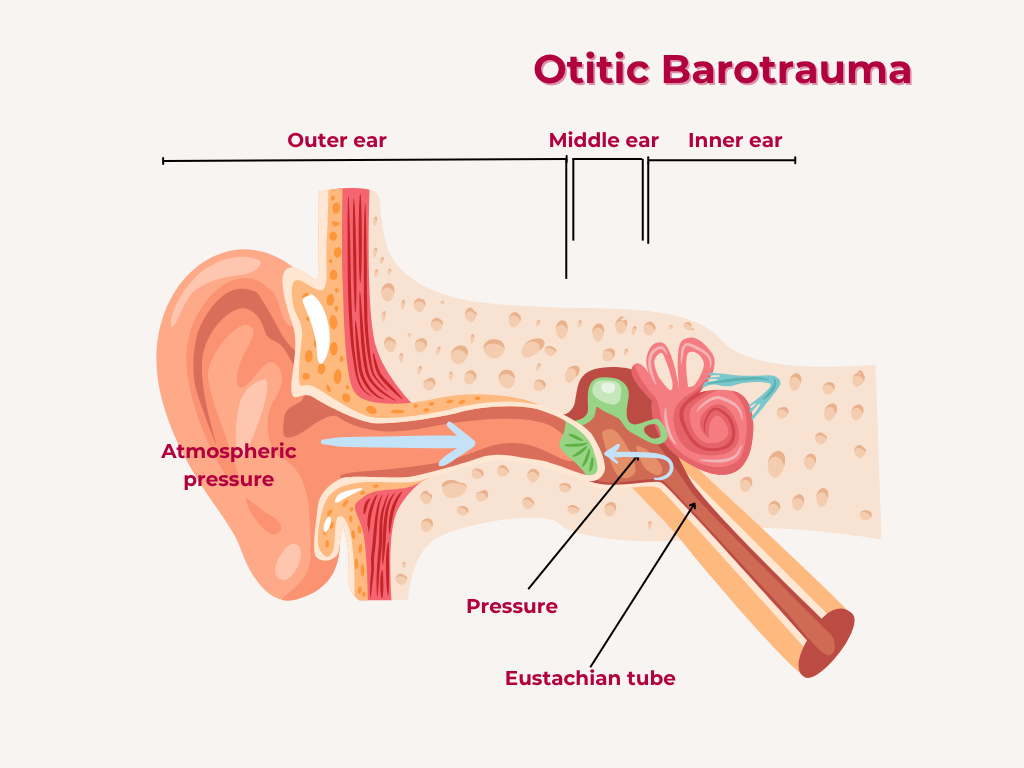Otitic barotrauma refers to injury to the middle ear caused by changes in atmospheric pressure, often occurring during activities like flying, diving, or traveling through tunnels.
Epidemiology
-
1. Common in:
Individuals who experience rapid changes in atmospheric pressure, such as divers, pilots, and passengers on airplanes.
-
2. Prevalence:
Varies depending on the population and activity.
Pathophysiology
-
1. Pressure changes:
Rapid changes in atmospheric pressure can cause Eustachian tube dysfunction, leading to middle ear damage.
-
2. Middle ear injury:
The tympanic membrane and middle ear structures can be injured due to pressure differences. Early presentation for evaluation and management prevent complications and improves the prognostic outcome.
Symptoms and signs
Otitic barotrauma symptoms may include:
1. Ear pain: Pain or discomfort in the ear.
2. Hearing loss: Temporary or persistent hearing loss.
3. Fullness: Feeling of fullness or pressure in the ear.
4. Tinnitus: Ringing or other sounds in the ear.
Investigations
Health providers may do the following diagnosis for Otitic barotrauma:
1. Otoscopy: Examination of the ear canal and tympanic membrane.
2. Tympanometry: Assessment of middle ear function.
3. Audiometry: Hearing tests to evaluate hearing loss.
Complications
Complications include:
1. Persistent hearing loss: Long-term hearing impairment.
2. Middle ear infection: Increased risk of infection due to Eustachian tube dysfunction.
3. Tympanic membrane perforation: Rupture of the eardrum.
Management of Otitic Barotrauma
Management and Treatment for Otitic barotrauma include:
Medical Management
1. Decongestants: Medications to reduce nasal congestion and promote Eustachian tube function.
2. Analgesics: Pain relief medications.
3. Valsalva maneuver: Technique to equalize middle ear pressure.
Surgical Management
1. Myringotomy: Surgical incision in the tympanic membrane to relieve pressure.
2. Tympanostomy tubes: Insertion of tubes to ventilate the middle ear.
3. Tympanic membrane repair: Surgery to repair a perforated eardrum.
The goal of management is to alleviate symptoms, prevent complications, and restore middle ear function.
Share Post On:
Recent Posts
-
Carcinoma of the Oropharynx
-
Peritonsillar Abscess
-
Ethics of Doctor-Patient Relationship
-
Doctor-Patient Relationship Case Scenarios
-
Asymmetrical Tonsils and Approach to Evaluation and Management
-
Nasal Polyposis
-
Rigid Oesophagoscopy and Complication
-
Anatomy of Oesophagus
-
Stridor, Snoring, Stertor And Wheezing: How They Compare
-
Temporomandibular Joint (TMJ)
-
Otoacoustic Emissions
-
Tympanometry
-
Functional Endoscopic Sinus Surgery (FESS)
-
Tracheostomy
-
Clinical Voice Test (CVT) for Hearing Loss
-
Acute Epiglottitis And Approach To Management
-
Synoptic Overview Of Nasopharyngeal Carcinoma
-
Prioritizing Support For People With Disabilities Over Unhealthy Competitions That Marginalise The Downtrodden
-
Otitic Barotrauma
-
Titbits of Informed Consent Process for a Medical or Surgical Procedure
-
Comprehensive Overview of Mpox (Monkeypox)
-
Overview Of Corrosive Ingestion - Acid & Alkalis, and Management Approach
-
Ethical Conundrum
-
Comprehensive Overview of Laryngeal Papillomatosis and HPV Virus
-
All You Need To *Know About Gardasil*
-
Preauricular Sinus
-
Laryngomalacia - comprehensive overview
-
Flexible Laryngoscopy features of Laryngomalacia
-
Case Report of a Rare Cause of Upper Airway Obstruction In Adults
-
Usefulness of The Neck Soft Tissues X-Ray
Categories
RELATED POSTS
Get in Touch
Read doctor-produced health and medical information written for you to make informed decisions about your health concerns.


